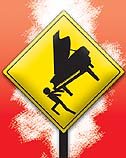Friday, July 7, 2006
I am surrounded by people with low back pain. It hurts to watch them—walking with that "can't stand up straight" shuffle, getting up from a chair and pausing to catch a breath, grimacing every time another searing pain shoots down their leg. Ouch. I remember it well.
Everyone who lives long enough eventually has some kind of back pain. Mine peaked about 10 years ago when I frequently lugged a washing machine-sized suitcase filled with heavy winter clothes through airports. Those things should have warning labels: "Caution: To be used only by Olympic-trained weight lifters." Large bulky items are notorious for enticing us to use brute force to push, pull and heave them into submission. But it doesn't take something the size of an elephant to pull your sacroiliac out of whack. It could be something as simple as scooping up your 40-pound puppy with one arm or spending the morning yanking Bermuda grass out of your flowerbed.
Fortunately, there are a zillion remedies to help solve your particular problem. For back pain, treatment ranges from surgery (which I plan to avoid like the plague), to smelly ointments, exercise to special furniture and braces, just to name a few. Usually a combination is best, but you must find the right combination for you. It's like peeling an onion-—just dig deeper revealing one layer at a time.
I started with the typical pain pill and muscle relaxer regimen. The muscle relaxer made me spacey. The pain pill, ibuprofen, may have been beneficial. It's a non-steroidal anti-inflammatory drug and there was surely some inflammation involved. Ibuprofen is sold over the counter under brand names like Motrin or Advil, Nuprin and Naprosyn. The drugs helped for a while but didn't solve the root cause. The pain returned.
Next, I read a book by Dr. John Sarno called "Healing Back Pain." Sarno suggests that our brain creates chronic back pain in order to distract us from things we don't want to think about. The same weekend I read the book, I turned every mattress in the house just to be sure it worked. I felt great. But eventually, the pain returned.
Not willing to give up, I made an appointment with a physical therapist. She checked me out and prescribed a series of exercises specifically for my body. I combined those with exercises from my chiropractor. Together they strengthened my upper body, lower back and abdominal muscles. I saw great improvement in posture, stamina and digestion (of all things). After a long while, some pain returned—but only now and then. When it does, I use ice, and it usually goes away. If it doesn't, I have a massage and get a chiropractic adjustment. The massage loosens the tension in the muscles paving the way for easy spinal manipulation. The adjustment gets the spine off inflamed nerves so they can heal. Research shows that chiropractic care is at least as effective as conventional medical treatment for chronic lower back pain, and may be more effective.
Adding meditation and regular energy healings can help the body stay more relaxed overall, making muscle injury and spasms less likely. Energy work comes in about as many flavors as ice cream. Reiki, Quantum Touch, Healing Touch, pranic healing, acupuncture and many others address the way the energy flows in and around the body. You can find practitioners locally with a little research. Breathing also plays an important role in pain management and healing. Many of us hold our breath when tense or take shallow breaths just into our chests, not deep into the diaphragm. Find a few minutes each day to concentrate on your breathing. Turn it in to your own form of energy healing by "breathing up from your feet" and pulling the energy through your spine. Hey, it's free, and it's worth a try.
Whatever you do, never give up. Don't believe anyone who tells you that nothing can be done. Your remedy may be entirely different from your neighbor's, and that's fine. Keep looking for what works for you.
MORE INFORMATION
National Center for Complementary and Alternative Medicine, National Institutes of Health
Healing Back Pain, "The Mind-Body Connection," John E. Sarno, M.D. Warner Books, 1991.

Comments
Use the comment form below to begin a discussion about this content.
Sign in to comment
Or login with:
OpenID